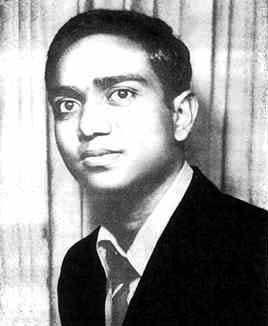
Vijay Kumar Patodi
 المؤلف:
Obituary: Vijay Kumar Patodi (1945-1976)
المؤلف:
Obituary: Vijay Kumar Patodi (1945-1976)
 المصدر:
Topology 16
المصدر:
Topology 16
 الجزء والصفحة:
...
الجزء والصفحة:
...
 13-4-2018
13-4-2018
 1248
1248
Born: 12 March 1945 in Guna, Madhya Pradesh, India
Died: 21 December 1976 in Bombay, India

Vijay Patodi attended the Government Higher Secondary School in Guna before entering Vikram University in Ujjain. After obtaining his B.Sc. degree from Vikram University, Patodi moved to Banares Hindu University were he studied for his Master's Degree in Mathematics. This was awarded in 1966 and Patodi then spent a year at the Centre for Advanced Study at the University of Bombay.
In 1967 Patodi joined the School of Mathematics of the Tata Institute of Fundamental Research in Bombay and he was to remain on the staff there until his death at the distressingly early age of 31.
Mathematical fame for Patodi came early in his career with papers of great importance coming for the work of his Ph.D. His doctoral thesis, Heat equation and the index of elliptic operators, was supervised by M S Narasimhan and S Ramanan and the degree was awarded by the University of Bombay in 1971.
Patodi's first paper Curvature and the eigenforms of the Laplace operator was part of his thesis and the contents of this paper are described in [2]:-
An analytic approach, via the heat equation yields easily a formula for the index of an elliptic operator on a compact manifold: but, the formula involves an integrand containing too many derivatives of the symbol, while from the Atiyah-Singer index theorem one would expect only two derivatives to figure. ... Patodi's first contribution was to prove that such a fantastic cancellation of higher derivatives did indeed take place.
The second paper which came from his thesis was An analytic proof of the Riemann- Roch- Hirzebruch theorem for Kaehler manifolds which extended the methods of his first paper to a much more complicated situation.
The years 1971 to 1973 were ones which Patodi spent on leave at the Institute for Advanced Study at Princeton. There he worked with M F Atiyah and made several visits to work with others in his field at various centres in the United States and England. During this time he also collaborated with R Bott and I M Singer.
On his return to Bombay and the Tata Institute in 1973 Patodi was promoted to associate professor. He was promoted to full professor in 1976 but by this time his health was very poor. He had in fact had to overcome health problems for most of his career, making his achievements the more remarkable.
Patodi's publications, in addition to the two mentioned above, include a number of joint ones with Atiyah and Singer. These papers introduce a spectral invariant of a compact Riemannian manifold. In another paper he studies the relationship between Riemannian structures and triangulations. Other work gives a combinatorial formula for Pontryagin classes.
Articles:
- Obituary: Vijay Kumar Patodi (1945-1976), Topology 16 (1) (1977), i.
- Vijay Kumar Patodi, Geometry and analysis : papers dedicated to the memory of V K Patodi (Bangalore, 1980), i-iii.
 الاكثر قراءة في 1940to the present
الاكثر قراءة في 1940to the present
 اخر الاخبار
اخر الاخبار
اخبار العتبة العباسية المقدسة


